How to arrange a rough floor on the balcony? What materials are best used for subsequent finishing: parquet or laminate, linoleum or carpet? What are the advantages and disadvantages of each type of surface?
Let us dwell in more detail on each of these questions in order to select the optimal technique for arranging a balcony, taking into account the technical capabilities of the premises and the estimated budget for repairs.





Device
Finishing balconies is directly related to the features of this element of the architecture of a residential building, because it imposes significant restrictions on the structure of floors and how to cover them.
The slab of the balcony is connected with the ceilings of the building on only one side, the other three are in the literal sense of the word “hanging”, so the technical capabilities of this element of architecture are far from unlimited. Any overload is fraught with collapse, so the number of possible options for finishing the balcony is significantly limited. Carry out any reconstruction on the balcony, including flooring, preferably after a thorough technical examination and engineering calculations.
It is possible that you will need to install an additional reinforcing structure before starting work. All these calculations can be carried out exclusively by professional architects.
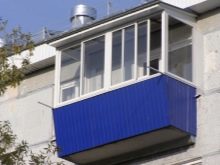
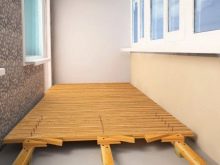

In most publications on the arrangement of the balcony, there is advice level floors with concrete screed. However, this recommendation is good only for loggias, a screed on them will allow you to create an even and wear-resistant base. But whether such a room with balconies will pass is a big question. Let's estimate what load the plate will experience:
- minimum allowable screed thickness -20-25 mm;
- waterproofing layer - at least 35 mm with the condition of mandatory reinforcement;
- cable, electric or water floor heating with the release of a thermal insulation layer - 45-50 mm.


In total, 100-115 mm is obtained, and this is only if we are talking about a screed of minimum thickness, that is, at the highest point of the balcony slab. In practice, most often there are significant distortions and deviations of the surface horizontally, therefore the screed requires additional surface leveling, in this case the coating thickness will increase, and the total floor load will reach far from ridiculous values.
And this is without taking into account the facing material. For example, if you use ceramic tiles, then it will give a significant weight load. But do not forget about the pieces of furniture and the weight of households who plan to relax on the balcony.



That is why professionals suggest abandoning the use of screeds for finishing floors on the balcony, as there are many other options for their alignment and finish. Of course, in the vast majority of cases, they involve the use of glazed balconies, protected from rain and snow, but on the other hand - is it necessary to level the surface on an open balcony?
It will be much more efficient and practical to limit the repair to the surface of the plate, if, of course, its technical condition is satisfactory. If the slab is sagging and cracked, the decorative finish, in principle, will not make any sense. In this case, the creation of a reinforcing structure and a major overhaul will be required.


Does it need to be insulated?
Very often, owners of balconies think about its insulation. There is no unequivocal recommendation about the need for such work - it all depends on what kind of functionality the owner of the room assigns to the fenced area. If he needs it as an unheated space for drying clothes and a rare exit “into the fresh air”, it makes no sense to engage in insulation, and if you plan to use the room as an additional room - as an office, a meeting place with friends and a children's playroom, then, without a doubt, You will need insulation of the existing room.
The fact is that concrete in itself is the most powerful accumulator of cold, and going out on it in the frosty season in home slippers, you run the risk of getting a severe cold. The situation is not the best in hot summer days - then the stoves are heated and begin to emit a stream of hot air, which makes staying on the balcony extremely uncomfortable.

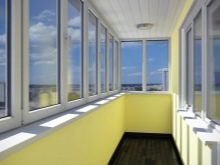

If you intend to glaze the balcony, then you need to think about its insulation even if you do not plan to install heating devices there.
It's obvious that there will be no point in warming the parapet if the floor remains icy.
It is believed that a qualitatively insulated balcony of neighbors from below does not allow low temperature to penetrate you, but this is far from the case. The specifics of the slab open on three sides lies in the fact that it will remain cold, regardless of whether the bottom is thermally insulated or not.



Types of flooring
The best option for the balcony will be the design of the draft floor using a wooden frame. This is a simple and relatively budget design, which consists of several layers:
- directly frame;
- insulation - most often use penoplex, expanded clay or mineral wool;
- flooring - Experts recommend the use of plywood or particle boards.


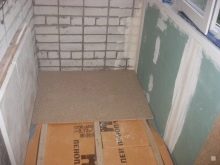
For the installation of the crate, wooden logs are used. They are fixed to the base of the balcony floor with anchors and form small cells for the subsequent installation of heat-insulating material.
Keep in mind that if you use mineral wool as a heat-insulating layer, then in addition you will have to take care of waterproofing - this material, unlike polystyrene, loses its technical and operational properties when wet. When choosing a topcoat, one should take into account the fact that a chipboard has a lower linear expansion parameter. This means that the plate is less susceptible to deformation and loses its shape only if it is in the water for a long time.
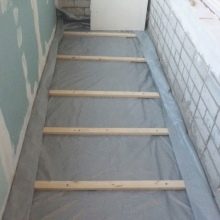


Warming materials minimize heat loss in the room, but they themselves do not emit heat, therefore if the balcony is in satisfactory condition, a floor heating system can be installed.
Of course, such work will cost an order of magnitude more expensive than a conventional wooden frame with insulation, but as a result you can get a full-fledged additional functional space that you can use as an office or as a resting place.



Usually use an electric cable or infrared film - their choice directly depends on the geometric features of the base. If the balcony is irregular in shape, then the best option would be a cable that can be fixed to any base without prior alignment. But for an infrared film, a flat surface and a strict rectangular plate shape are of fundamental importance. The main advantage of the film is that the floor finish can be laid directly on it, while the use of cable will inevitably require the installation of a screed.
Keep in mind that underfloor heating requires further costs, since the system will require power - the average cost of electricity ranges from 100-200 W / m2.

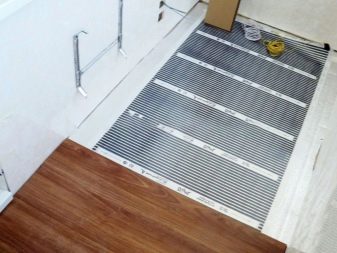
What is better to lay?
A variety of materials can be used to finish the floor on the balcony. Let us dwell on the pros and cons of each of them.
Linoleum It is presented in retail outlets in the widest assortment; it can be rubber, as well as glyphthal, colloxylin, natural or PVC. Rubber-based materials are considered the most durable coatings - for balconies, it is worthwhile to give preference to just such a coating, since it does not fear water and temperature fluctuations, is fire resistant and can withstand loads.
If you plan to use the balcony as an extra room, natural materials will suit you. Such a coating is more expensive, but it is environmentally friendly, it does not emit harmful and toxic substances, and it looks rich.
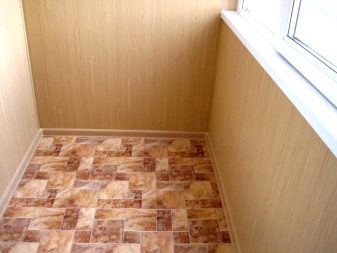



Linoleum resists moisture, is not susceptible to decay, has noise and heat insulation properties, is easy to clean and at the same time cheap. At the same time, it is characterized by increased sensitivity to chemically active solutions and fats, and at temperatures below -20 degrees, the coating may crack. Not the best choice will be the cheapest products. As a rule, they are made from synthetic non-environmentally friendly materials.



Carpet is another option for budget coverage, but when using it on the balcony, you should weigh the pros and cons. On the one hand, this coating is warm and pleasant “to the body” in any season, therefore it is optimal for a place of rest, however, due to the low fire resistance, this material is not recommended if you plan to use the balcony as a “smoking room” or as a storage room.
The carpet quickly absorbs dust, smell, including cigarette, which means you have to clean it regularly, especially if young children have access to the room. If you plan to use the balcony as a place for drying clothes or as a winter garden, preference should be given to rubber-based models.
Carpet contributes to the creation of an atmosphere of warmth and cosiness in space, quickly fits and has a reasonable price. But it is flammable and does not withstand high humidity.



Laminate is a material based on wood and polymers. The top layer is made of paper with patterns coated with several layers of acrylic resin, and the more there are, the more resistant the surface will withstand moisture and pressure. Currently on sale you can find materials with a variety of colors and textures. The highest demand is imitation wood or natural stone.





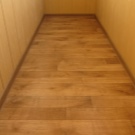
Laminate is more expensive than carpet and linoleum, but its appearance is much more aesthetic and spectacular. The material eliminates the occurrence of fungus and dangerous mold. At the same time, the coating is difficult in terms of installation - this work requires a perfectly aligned surface and finishing skills. In addition, the laminate does not withstand temperature fluctuations and prolonged frosts, so inside the balcony, even in winter, it should not be colder than -5 degrees.
In addition, the laminate helps to create an acoustic effect.



Parquet board is a natural, environmentally friendly and exceptionally beautiful coating. Nevertheless, most types of wood are not particularly resistant to water, so the installation of such floors is allowed only in the case of high-quality heat and water insulation and general insulation of the balcony. If it is damp and cold, then the parquet will quickly become worthless - it will begin to deform and crack.
At a minimum, this leads to an unpleasant creak during movement, at a maximum it will contribute to the appearance of fungus and mold, and in general will make the room look unpresentable.

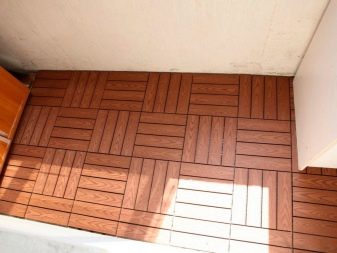
If you are resistant in your desire to decorate the floor from eco-friendly coatings, then preference should be given varieties of wood, poorly susceptible to cold and water, and after installing the floor of the panel, it is necessary to cover it several times with moisture-resistant varnish for effective protection from external adverse factors.
To summarize the cost of material, installation work, all this makes parquet the most expensive coating.



Ceramic tile is a practical material that is ideally suited for outdoor applications, as it is not afraid of ultraviolet rays, precipitation and can withstand temperature extremes. Such a surface is easily and simply washed from contamination, even using abrasive products. When choosing, give preference to coatings with a rough surface, otherwise there is a great risk of slipping after wet cleaning on the balcony. High-quality ceramics can withstand temperatures up to -50 degrees, so the tile does not lose its performance in winter or summer.
However, ceramics refers to cold materials, and therefore walking on such a surface is unpleasant.
It is best to cover the tiles with an additional carpet.




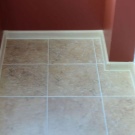
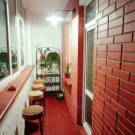
Well, the most budgetary option is paint, wooden and concrete floors can always be simply enameled. It is best to take acrylic compounds that are resistant to direct sunlight, do not lose their physical properties under the influence of high and low temperatures, and are not afraid of moisture. For wooden floors, an alkyd varnish will be a good option - it will save the spectacular texture of the tree. A good option can be a polyurethane paint.


If you are not limited in budget, you can trim the floor on the balcony using bulk technologies.


Work recommendations
Regardless of which version of the subfloor and decorative coating you prefer, first you need to carefully repair all chips, as well as cracks and crevices on the surface of the balcony slab using construction foam, only after that it will be possible to move on. Special attention will have to be paid waterproofing which will protect the material from condensation and capillary moisture.


Most often used in the decoration of floors wooden logs, which is a beam over which boards are laid. Usually for balcony spaces using bars measuring 50x70 mm or 50x100 mm.Before installation, each of them must be carefully treated with an antiseptic that will protect the subfloor from rot.
In order to make the floors resistant to pressure, it is advisable to put the bars on the ribs parallel to any wall. Usually one lag is fixed in the center and a couple of sides. They should be fixed as firmly as possible, directly to the concrete slab through, this will require metal corners or anchor screws.
Heat-insulating material is laid between the lags, while it is not necessary to bring it to the top - A small gap between the insulation and the flooring requires ventilation of the floor. In order to protect the thermal insulation from moisture, it is better to cover it with polyethylene, fixing it to the logs with an ordinary construction stapler.


Particle boards are suitable for flooring, but it is best to take plywood - it has the necessary strength, but at the same time it is lightweight.
How to use the coating depends on the purpose of the object and your capabilities. If budgetary constraints are at the forefront, feel free to choose linoleum. If finances allow you to consider options - proceed from functional criteria. For example, in a place of rest or gaming it is better to choose environmentally friendly coatings. Cheap linoleum is inappropriate here - it smells bad, moreover, toxic substances are often released. Better coatings on a natural basis - as an option, you can choose a laminate or parquet board.


For meetings with friends or sports training, a carpet is suitable - such a coating will allow you to relax your legs after a tiring working day, and in addition, eliminate the possibility of slipping.
Many use the balcony as a flower garden. It's no secret that plants need to be watered and sprayed, because the room is usually high humidity. Ceramic tiles "get along" with it best.

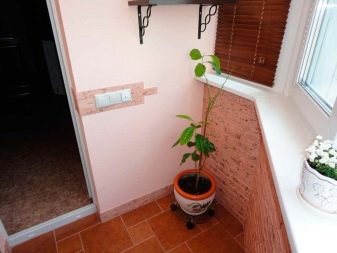
A master class on decorating the floor on the balcony, see the next video.










